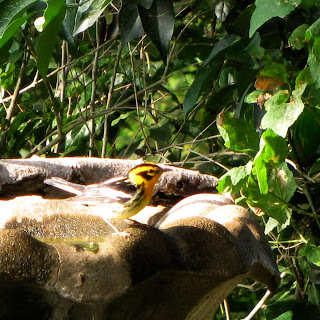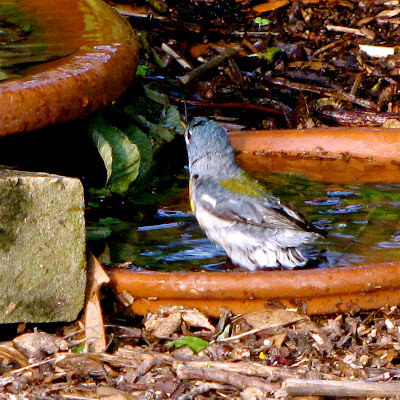Watching warblers wouldn't be nearly so much fun if it were always easy to identify each one. If they are high in the trees or flittering around too much, or if they are just one of those drab "confusing fall warblers" (as the Peterson Guides admonish), it's really--well, confusing. Even in spring when warblers are not usually drab I can be confused.
I think I'm looking carefully, in minute detail, at each field mark--but then when I consult the guide I find I have forgotten to notice if the vent is yellow or the eye-ring broken. Thank goodness now for cameras that can zoom in close and let me examine the birds at my leisure after I've left the yard and the exciting sport of backyard warbler-watching. But even then, I can't always tell if the bird really has a yellowish tint on its underparts or if that's just the sun reflecting off its whitish feathers.
I think the bird above is a Nashville warbler. No wing bars. Olive back. Eye-ring and yellowish underparts. In other photos of it, it almost looks to be an Orange-crowned, another drab warbler. But this picture was taken in late April and the wintering OCWAs were mostly gone. So I say Nashville. It's my yard.
This week Nashville Warblers and Tennessee Warblers were everywhere. Today I watched a Tennessee Warbler (small, olive-green but with an eye-line rather than an eye-ring) eat cranberry jelly from an orange half right outside the window. (The Golden-fronted Woodpeckers had cleaned out the last of the orange halves, so I just filled them with grape jelly. When the migrating Baltimore Orioles gobbled up all the grape jelly, I refilled them with cranberry jelly.) Field guides say the OCWA and TEWA are the same size, but this Tennessee looked really tiny. Even from a few inches away on my window sill. I guess it's the slimmer head makes it seems so miniscule.
 |
| Blue-headed Vireo |
Warblers have sharp little beaks which distinguish them from vireos. I try to remember to look at the beak of small birds first to try to place them in categories. A Philadelphia Vireo, for example, is similar to a warbler but its larger vireo beak is a distinguishing clue.
Four vireo species joined the yard party at this week's spring fling: Philadelphia, Blue-headed, White-eyed and Red-eyed. The phillies' bar-less wings and yellowish underparts make it easy to confuse with wing-bar-less warblers, but the vireo beak, slightly bigger than a warbler's, helped me identify it.
 |
| Red-eyed Vireo |
I've digressed about the vireos. Let's get back to the warblers. Most of them were anything but drab and most, if they weren't at the birdbath were in the live oak, tallest tree in the yard. A Black and White Warbler scurried up and down the trunk, a Cerulean Warbler gleaned the topmost leaves, and a Blackpoll hid in the leaves so that I almost thought it was another Black and White. All of these were in the shadows or too quick for a snapshot.
 |
| Blackburnian Warbler |
I did, however, get a somewhat fuzzy photo of what's long been my favorite warbler. I had not seen one in several years, but the pattern of the bright orange and black was unmistakable.
My first Blackburnian was in the Smokey Mountains on a camping trip thirty plus years ago. I was an adult, but I'd been dreaming of Blackburnian Warblers since I was a kid pouring over the Roger Tory Peterson field guide. Living in Oklahoma, we didn't see a lot of the brightest warblers. I had hoped to see one on our trip to the east and I was thrilled when I did. That was then; this is now. Here in the Rio Grande Valley it's almost like I have the whole field guide in my own backyard.
When sorting out warblers, or just dreaming about seeing them, I always consult a variety of field guides. Peterson's guide is still the best for drawings of warblers. Though I've purchased the Peterson warbler app for my iphone, I still browse the warbler pages of the latest Peterson guide when I'm hoping for a warbler drop-day. I especially like the way the pages are organized with similar birds on the same pages. For example, Black and White, Blackpoll, and Cerulean Warblers are pictured on a page of "Warblers: Black-striped, gray, or bluish." I'm looking now at the plate titled "Warblers: Orange or chestnut patches" and just realized that on Tuesday I saw all five of the birds on this beautifully drawn page: Cape May Warbler, Chestnut-sided Warbler, Bay-breasted Warbler, Blackburnian Warbler, and American Redstart!
 |
| Roger Tory Peterson signs my old field guide. |
[When Roger Tory Peterson came to the first Rio Grande Valley Birding Festival seventeen years ago, I asked him to sign my first field guide, one my father gave me when I was eight years old.
An elderly man by then, Peterson still birded the world and spoke at the festival about a recent trip to Antarctica. A world birding expert, he considered the Rio Grande Valley one of the top birding spots in the country. I agree with him. For me, the top birding spot is sitting in an easy chair in my own backyard.]
More visitors to our backyard Spring Fling:
Black-throated Gray Warblers are often in the yard in the winter. This one might have been here for a while or it might be part of the horde of travelers this Spring. It will go north along with other migrants.
The yellow-capped, chestnut-sided Chestnut-sided Warbler is cheerful looking, cocking its tail much like a wren.
Northern Parulas have a distinctive patch of yellow-green on their backs. A dark band washed with orange on the breast below a yellow throat makes this bluish colored warbler one of the loveliest.
I am assuming this Waterthrush is a Northern because of the lateness of its migration. About a month ago I supposed the waterthrushes were Louisiana which migrate in earlier spring.
Nothing says Spring better than a bright yellow Yellow Warbler. Its rusty breast streaks indicate that it is a male.
This bright guy is a Magnolia Warbler, one of the loveliest warblers of all. My Ibird Pro app tells me a group of these is known as a bouquet. How appropriate for such a spring beauty!
A male American Redstart is bright and fluttery like a butterfly. Along the driveway, where a thicket of trees and shrubs (brasil, fiddlewood, granjeno, anaqua) provide cover and berries, half a dozen American Redstarts flittered and looked at me with curiosity.
I heard the Common Yellowthroat's witchety witchety witchety witch and finally located him in the butterfly garden.
Not to be outdone by the birds, this Anole is another splash of color in the butterfly garden.
The magic of migration and the possibilities of a spectacular fallout of warblers is alive in our small yard. The yard is quieter today but some of our Drop Day birds linger, and new ones continue to arrive. I'll post pictures of orioles, grosbeaks, and thrushes tomorrow. Look for Spring Fling, part three.












9 comments:
Love all the pretty warblers, great photos and sightings. Happy Mother's Day!
Such a neat picture of you with Roger Tory Peterson. Something to treasure. Love your photos and commentary.
What a plethora of colorful birds. I'm so jealous. I only heard my first warbler, (Yellow-rumped) of the season this morning. Is it safe to assume that your vireo photo above the Red-eyed Vireo is a Blue-headed? The text off to the side mentions only Philadelphia Vireo.
My autographed Peterson guide is also one of my treasures. It never goes into the field with me.
Hi, John-
yes, that's a blue-headed. I did not get a photo of the PHVI and didn't even see the WEVI, just heard its unmistakable call.
My original Peterson is crumbling. I have had it since about 1956! Seeing Peterson was a real treat. It was only about a year later that he passed away.
Kay
Eileen,
Thanks--and happy Mother's Day to you too.
Kay
Thanks, Dave! I loved seeing the birds and writing about them. It was a fling, indeed!
Kay
Wow, lots of warbler action!! That's one thing that I enjoy about springtime in my area - the return of the warblers! Nice photos as well.
Alan
Thanks Alan. I'll never tire of watching warblers.
K.
Holy moly, your yard is better than any birding spot around!
Post a Comment